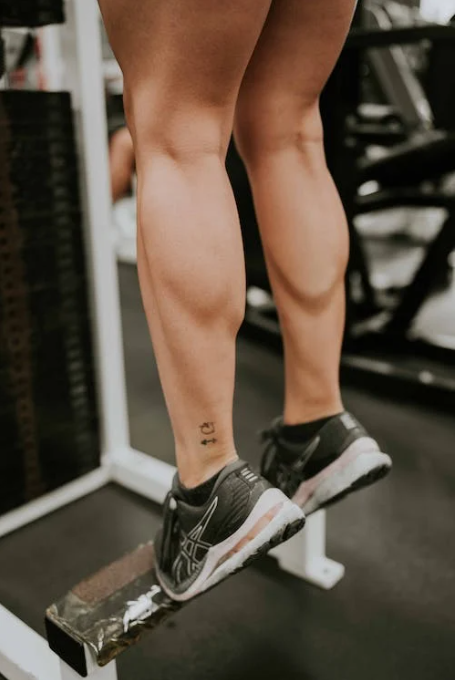The biggest misconception that I hear among people who lift weights is that you can’t grow your calves. Meaning that whatever calves you have are the ones you’ll have forever.
I’ve even heard some people say that they never train calves, because they can’t grow them.
Well, that’s why I’m here, to clear up this misconception. You can absolutely grow your calves in the gym!
Don’t believe the rumors you’ve heard. No matter who you are, it’s entirely possible to grow your calves in the gym.
However, there are some things you should know in order to maximize your calf growth.
In this post you’ll find:
Are your calves really “just genetic”?
The biggest misconception I hear when it comes to growing your calves is that people believe their calves are entirely genetic. Meaning that they can’t grow.
Now this makes sense, but it also doesn’t. Think about it, isn’t every muscle we have based on genetics? Yes!
You wouldn’t just not train your quads or biceps because they’re “just genetic”.
Your genetics determine your muscle insertions, length, size, and how they grow. But this is the case for every single muscle, not just your calves.
So yes, your calves are genetic, but that doesn’t mean they can’t grow.
The biggest calf growth mistakes you don’t want to be making!

You’re not training intensely enough
In order to grow any muscle, you need to be training it intensely. To train intensely means you need to be lifting heavy enough, as well as doing enough volume, or number of reps.
Think about it, your calves are used to carrying your bodyweight around ALL DAY.
Anytime you walk, run, jump, or anything your calves are carrying your weight. This means they’re used to and capable of carrying a lot of heavy weight around. As a result, in order for them to grow, you need to put them under even more intensity than what they’re used to.
While keeping this in mind, you need to be training to failure, or close to it, in most of the exercises you do in the gym.
That is, if you’re training to grow your muscles.
For most people who lift weights to grow their muscles, they’re either training for strength or hypertrophy.
Hypertrophy vs. strength
Hypertrophy means you’re training for muscle growth. It’s the style of training that many body builders use. Whereas training for strength means you’re training to, well, gain strength.
To go more about the hypertrophy route of training, you need to be lifting the right weight and doing the correct number of reps. By doing this to allow yourself to train intensely and to failure.
Generally, the best way to train for hypertrophy is to be lifting a weight that allows you to hit failure in the 8-12 rep range.
By doing this, you allow yourself to train intensely and to failure. Where training to failure means you’re training to the point where you can’t do anymore full reps with proper form.
If you’ve been consistently training your calves but still feel like you’ve seen no progress, the most likely culprit is a lack of intensity.
By implementing this training style, you’re able to skyrocket the intensity on every set of your calf workout.
I guarantee you that if you do this consistently you’ll be sure to see growth in your calves.
Lifting too heavy and sacrificing range of motion
When you’re training your muscles to grow, you need to have a proper range of motion. Most often, the greater your range of motion, the more muscle growth you can stimulate.
Why does range of motion stimulate growth?
The reason for this is the better range of motion you have, the better stretch you can get on your muscle. During this stretch, you’ll be putting much more tension on your muscles and allowing for more tears to be made.
Think about it, if the stretch is one of the main parts of your rep that stimulates muscle growth, wouldn’t you want to extend the amount of time that your muscle spends in this stretch?
You can do that by taking it through it’s entire range of motion.
Heavy weight impacts range of motion
Especially when you’re training your calves, it’s extremely easy to not realize that lifting weight that’s too heavy is causing you to sacrifice your range of motion.
This is because when you’re training calves, you’re most likely standing or sitting with the balls of your feet elevated and your heels off the edge.
If the weight is too heavy, you won’t be able to lower your heels down as far as they should go. It’s not only important to be able to lower your heels all the way, but to make sure your calves are what’s controlling the weight as you lower it.
If the weight is too heavy, it’s easy for your knees, ankles, and other muscles to take control over the weight. This takes most of the tension off of your calves and puts it into other areas.
Because of this, it’s important to train your calves with heavy weight, but not so heavy that your calves can’t control it or you sacrifice your range of motion.
You don’t train your calves like you would any other muscle
In order to grow your calves, you have to treat them like you would any other muscle. By this I mean you have to train them like you would train any other muscle you wanted to grow.
Let’s say you were trying to grow your shoulders. You most likely wouldn’t train them only once a week or every couple weeks.
Or, you wouldn’t “forget” to train them or do just one shoulder exercise at the end of your workout.
You would most likely do multiple shoulder exercises, training intensely during each one, multiple times a week.
The same would go for probably any other muscle you were trying to grow, and the same should go for your calves!
Your calves are just like any muscle in your body. They’re just as capable of growth as all the other muscles.
It’s important to be honest with yourself. Ask yourself if you’re actually training your calves like you would any other muscle you’re trying to grow.
Don’t skimp out on your calf training and expect to see results.
You always save calves until the end of your workout (and usually end up skipping them)
For most of us, there’s one way to sum up how we feel at the end of a leg day: exhuasted.
Because you use up more and more energy throughout your workout, you’ll have the least amount of energy for the last exercises you do.
As a result, if you’re always saving your calf exercises for the very end of your workout, you’re never going to have enough energy to do them as intensely as you could.
Additionally, I don’t know about you, but after my two hour intense leg day, I’m ready to get out of there. If you feel the same way, you might end up skipping your calf exercises, rushing through them, or skipping a set or two and thinking “it’s fine it’s just calves”.
By doing this though, there’s no way you can expect your calves to grow.
If you want to see growth, you can’t be skimping out on your calf exercises.
Now, I’m not saying you are. But it’s easy to loose track of how often you might overlook your calf workouts.
Here are the changes you can make to start growing your calves after your next workout

Now that we’ve covered the biggest misconceptions and most common mistake when it comes to calf growth, we can get into the real important stuff. How to actually grow your calves!
Try not training calves on your leg days
Now this might seem weird to some people, but I’ve tried this one for myself and it works wonders.
Like I was saying before, by the end of my intense leg day, after I’ve been at the gym for 2 hours, I’m ready to go.
The last thing I’d want to be doing is training calves. Because of this, I’d probably end up skipping them.
If you feel the same way, then this tip is for you. Instead, what you can try doing is doing calves on one of the other days of your split. One that’s not a leg day.
Because my leg days take the longest, doing calves on a different day, like an upper body day, allows me to focus much more on training my calves intensely.
I have much more energy on my upper body days and my legs aren’t fatigued by the end of them. As a result, I can truly get an intense workout on my calves.
And, because I haven’t been at the gym as long as I would’ve been if it were a leg day, I never feel like skipping or rushing through my calf workout.
Implement standing and sitting calf raises
Both standing calf raises and sitting calf raises target your calves differently.
I find I’m able to get a much better stretch on standing calf raises. Because of this, I prefer standing over sitting.
However, if you really want to grow your calves, it would be best to implement both. This will allow you to get a great calf workout and target all the different muscles in your calves.
If your gym doesn’t have a standing calf raise machine, you can always use a smith machine. I like to put a two 45lb plates on the ground, one on top of the other, and stand with my heels off the edge.
Then, perform your calf raises like you would on a calf raise machine.
Start doing partial reps
Partial reps is an excellent strategy to grow any muscle in your body. Doing these helps take the intensity of your workout to the absolute next level.
The way you implement partial reps is to first train to failure with a full range of motion. Then, when you can’t or almost can’t do anymore full reps with a full range of motion, you start doing partial reps.
Partial reps means you do the rep with good form, you just don’t complete the full rep. Mainly because you can’t and don’t have enough energy.
By doing this, you can fatigue your muscles even more than you would by just training to failure.
Try single leg calf raises
If you don’t feel like you get enough out of regular calf raises, you can try doing single leg calf raises.
Single leg calf raises are a variation of regular calf raises that allow you to train just one calf at a time.
Doing these allow you to target one calf at a time.
Targeting only one calf at a time brings a coupe benefits to your training.
First off, you can focus more on just the one calf that’s working. Secondly, you don’t need to load up as much weight and can potentially just use your bodyweight.
And finally, this is a new variation of a calf raise to target your calves in a different way. Working your calves in a different way and doing a bilateral movement can help grow and target muscles that wouldn’t otherwise be engaged.
Takeaways
In order to grow your calves, you have to overcome the belief that your calves are just genetic. All your muscles are genetic!
As a result, it’s entirely possible to grow your calves, as it’s possible to grow any other muscle.
By avoiding the biggest calf training mistakes and instead implementing certain training strategies, you’ll be sure to see calf growth in no time!
More of my posts on weightlifting:
How to increase your squat range of motion